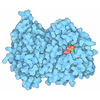+ Open data
Open data
- Basic information
Basic information
| Entry | Database: PDB / ID: 7k7g | ||||||
|---|---|---|---|---|---|---|---|
| Title | nucleosome and Gal4 complex | ||||||
 Components Components |
| ||||||
 Keywords Keywords | DNA BINDING PROTEIN/DNA / DNA BINDING PROTEIN / DNA BINDING PROTEIN-DNA complex | ||||||
| Function / homology |  Function and homology information Function and homology informationCBF3 complex / RNA polymerase I upstream activating factor complex / septin ring assembly / sexual sporulation resulting in formation of a cellular spore / HATs acetylate histones / cupric reductase (NADH) activity / global genome nucleotide-excision repair / Condensation of Prophase Chromosomes / SIRT1 negatively regulates rRNA expression / Activated PKN1 stimulates transcription of AR (androgen receptor) regulated genes KLK2 and KLK3 ...CBF3 complex / RNA polymerase I upstream activating factor complex / septin ring assembly / sexual sporulation resulting in formation of a cellular spore / HATs acetylate histones / cupric reductase (NADH) activity / global genome nucleotide-excision repair / Condensation of Prophase Chromosomes / SIRT1 negatively regulates rRNA expression / Activated PKN1 stimulates transcription of AR (androgen receptor) regulated genes KLK2 and KLK3 / Assembly of the ORC complex at the origin of replication / centromeric DNA binding / HDACs deacetylate histones / kinetochore assembly / Recruitment and ATM-mediated phosphorylation of repair and signaling proteins at DNA double strand breaks / replication fork protection complex / RMTs methylate histone arginines / Oxidative Stress Induced Senescence / postreplication repair / DNA binding, bending / prenyltransferase activity / isoprenoid biosynthetic process / positive regulation of transcription by RNA polymerase I / mitotic spindle assembly checkpoint signaling / RNA Polymerase I Promoter Escape / nucleolar large rRNA transcription by RNA polymerase I / Estrogen-dependent gene expression / rRNA transcription / intracellular copper ion homeostasis / Ub-specific processing proteases / CENP-A containing nucleosome / nucleosomal DNA binding / aerobic respiration / heterochromatin formation / kinetochore / structural constituent of chromatin / nucleosome / chromatin organization / DNA-binding transcription factor activity, RNA polymerase II-specific / protein heterodimerization activity / DNA repair / regulation of DNA-templated transcription / negative regulation of transcription by RNA polymerase II / DNA binding / zinc ion binding / identical protein binding / nucleus Similarity search - Function | ||||||
| Biological species |  | ||||||
| Method | ELECTRON MICROSCOPY / single particle reconstruction / cryo EM / Resolution: 4.2 Å | ||||||
 Authors Authors | Ruifang, G. / Yawen, B. | ||||||
 Citation Citation |  Journal: Nat Commun / Year: 2021 Journal: Nat Commun / Year: 2021Title: Structural and dynamic mechanisms of CBF3-guided centromeric nucleosome formation. Authors: Ruifang Guan / Tengfei Lian / Bing-Rui Zhou / Emily He / Carl Wu / Martin Singleton / Yawen Bai /   Abstract: Accurate chromosome segregation relies on the specific centromeric nucleosome-kinetochore interface. In budding yeast, the centromere CBF3 complex guides the deposition of CENP-A, an H3 variant, to ...Accurate chromosome segregation relies on the specific centromeric nucleosome-kinetochore interface. In budding yeast, the centromere CBF3 complex guides the deposition of CENP-A, an H3 variant, to form the centromeric nucleosome in a DNA sequence-dependent manner. Here, we determine the structures of the centromeric nucleosome containing the native CEN3 DNA and the CBF3core bound to the canonical nucleosome containing an engineered CEN3 DNA. The centromeric nucleosome core structure contains 115 base pair DNA including a CCG motif. The CBF3core specifically recognizes the nucleosomal CCG motif through the Gal4 domain while allosterically altering the DNA conformation. Cryo-EM, modeling, and mutational studies reveal that the CBF3core forms dynamic interactions with core histones H2B and CENP-A in the CEN3 nucleosome. Our results provide insights into the structure of the budding yeast centromeric nucleosome and the mechanism of its assembly, which have implications for analogous processes of human centromeric nucleosome formation. | ||||||
| History |
|
- Structure visualization
Structure visualization
| Movie |
 Movie viewer Movie viewer |
|---|---|
| Structure viewer | Molecule:  Molmil Molmil Jmol/JSmol Jmol/JSmol |
- Downloads & links
Downloads & links
- Download
Download
| PDBx/mmCIF format |  7k7g.cif.gz 7k7g.cif.gz | 259.8 KB | Display |  PDBx/mmCIF format PDBx/mmCIF format |
|---|---|---|---|---|
| PDB format |  pdb7k7g.ent.gz pdb7k7g.ent.gz | 203.4 KB | Display |  PDB format PDB format |
| PDBx/mmJSON format |  7k7g.json.gz 7k7g.json.gz | Tree view |  PDBx/mmJSON format PDBx/mmJSON format | |
| Others |  Other downloads Other downloads |
-Validation report
| Summary document |  7k7g_validation.pdf.gz 7k7g_validation.pdf.gz | 851.1 KB | Display |  wwPDB validaton report wwPDB validaton report |
|---|---|---|---|---|
| Full document |  7k7g_full_validation.pdf.gz 7k7g_full_validation.pdf.gz | 861.3 KB | Display | |
| Data in XML |  7k7g_validation.xml.gz 7k7g_validation.xml.gz | 31.8 KB | Display | |
| Data in CIF |  7k7g_validation.cif.gz 7k7g_validation.cif.gz | 48.7 KB | Display | |
| Arichive directory |  https://data.pdbj.org/pub/pdb/validation_reports/k7/7k7g https://data.pdbj.org/pub/pdb/validation_reports/k7/7k7g ftp://data.pdbj.org/pub/pdb/validation_reports/k7/7k7g ftp://data.pdbj.org/pub/pdb/validation_reports/k7/7k7g | HTTPS FTP |
-Related structure data
| Related structure data |  22698MC  7k78C  7k79C M: map data used to model this data C: citing same article ( |
|---|---|
| Similar structure data |
- Links
Links
- Assembly
Assembly
| Deposited unit | 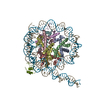
|
|---|---|
| 1 |
|
- Components
Components
-Protein , 4 types, 8 molecules AEBFCGDH
| #1: Protein | Mass: 15391.007 Da / Num. of mol.: 2 Source method: isolated from a genetically manipulated source Source: (gene. exp.)  Strain: ATCC 204508 / S288c / Gene: HHT1, YBR010W, YBR0201, HHT2, SIN2, YNL031C, N2749 / Production host:  Escherichia phage EcSzw-2 (virus) / References: UniProt: P61830 Escherichia phage EcSzw-2 (virus) / References: UniProt: P61830#2: Protein | Mass: 11395.390 Da / Num. of mol.: 2 Source method: isolated from a genetically manipulated source Source: (gene. exp.)  Strain: ATCC 204508 / S288c / Gene: HHF1, YBR009C, YBR0122, HHF2, YNL030W, N2752 / Production host:  Escherichia phage EcSzw-2 (virus) / References: UniProt: P02309 Escherichia phage EcSzw-2 (virus) / References: UniProt: P02309#3: Protein | Mass: 14013.177 Da / Num. of mol.: 2 Source method: isolated from a genetically manipulated source Source: (gene. exp.)  Strain: ATCC 204508 / S288c / Gene: HTA1, H2A1, SPT11, YDR225W, YD9934.10 / Production host:  Escherichia phage EcSzw-2 (virus) / References: UniProt: P04911 Escherichia phage EcSzw-2 (virus) / References: UniProt: P04911#4: Protein | Mass: 14280.362 Da / Num. of mol.: 2 Source method: isolated from a genetically manipulated source Source: (gene. exp.)  Strain: ATCC 204508 / S288c / Gene: HTB1, H2B1, SPT12, YDR224C, YD9934.09C / Production host:  Escherichia phage EcSzw-2 (virus) / References: UniProt: P02293 Escherichia phage EcSzw-2 (virus) / References: UniProt: P02293 |
|---|
-DNA chain , 2 types, 2 molecules IJ
| #5: DNA chain | Mass: 45334.012 Da / Num. of mol.: 1 Source method: isolated from a genetically manipulated source Source: (gene. exp.)  Production host:  Escherichia phage EcSzw-2 (virus) Escherichia phage EcSzw-2 (virus) |
|---|---|
| #6: DNA chain | Mass: 45399.992 Da / Num. of mol.: 1 Source method: isolated from a genetically manipulated source Source: (gene. exp.)  Production host:  Escherichia phage EcSzw-2 (virus) Escherichia phage EcSzw-2 (virus) |
-Protein/peptide / Non-polymers , 2 types, 3 molecules M

| #7: Protein/peptide | Mass: 5605.748 Da / Num. of mol.: 1 Source method: isolated from a genetically manipulated source Source: (gene. exp.)  Strain: ATCC 204508 / S288c / Gene: CEP3, CBF3, CBF3B, CSL1, YMR168C, YM8520.17C / Production host:  |
|---|---|
| #8: Chemical |
-Details
| Has ligand of interest | Y |
|---|
-Experimental details
-Experiment
| Experiment | Method: ELECTRON MICROSCOPY |
|---|---|
| EM experiment | Aggregation state: PARTICLE / 3D reconstruction method: single particle reconstruction |
- Sample preparation
Sample preparation
| Component | Name: the nucleosome and Gal4 domain complex / Type: COMPLEX / Entity ID: #1-#7 / Source: RECOMBINANT |
|---|---|
| Source (natural) | Organism:  |
| Source (recombinant) | Organism:  Escherichia phage EcSzw-2 (virus) Escherichia phage EcSzw-2 (virus) |
| Buffer solution | pH: 7.3 |
| Specimen | Embedding applied: NO / Shadowing applied: NO / Staining applied: NO / Vitrification applied: YES |
| Vitrification | Cryogen name: ETHANE |
- Electron microscopy imaging
Electron microscopy imaging
| Experimental equipment |  Model: Titan Krios / Image courtesy: FEI Company |
|---|---|
| Microscopy | Model: FEI TITAN KRIOS |
| Electron gun | Electron source:  FIELD EMISSION GUN / Accelerating voltage: 300 kV / Illumination mode: SPOT SCAN FIELD EMISSION GUN / Accelerating voltage: 300 kV / Illumination mode: SPOT SCAN |
| Electron lens | Mode: BRIGHT FIELD |
| Image recording | Electron dose: 71 e/Å2 / Film or detector model: GATAN K2 SUMMIT (4k x 4k) |
- Processing
Processing
| CTF correction | Type: NONE |
|---|---|
| 3D reconstruction | Resolution: 4.2 Å / Resolution method: FSC 0.143 CUT-OFF / Num. of particles: 115666 / Symmetry type: POINT |
 Movie
Movie Controller
Controller






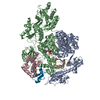
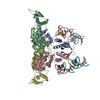




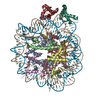
 PDBj
PDBj






































